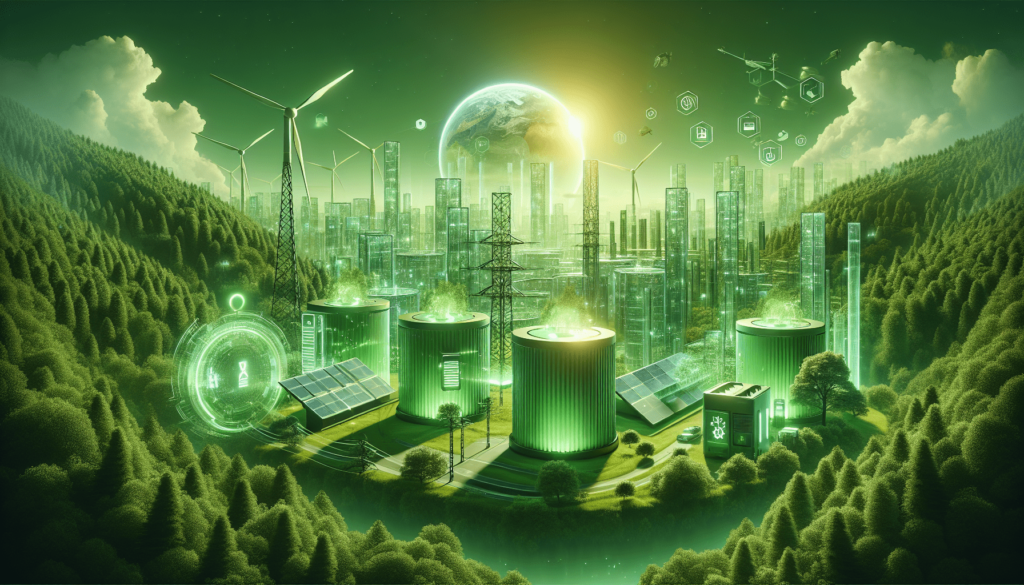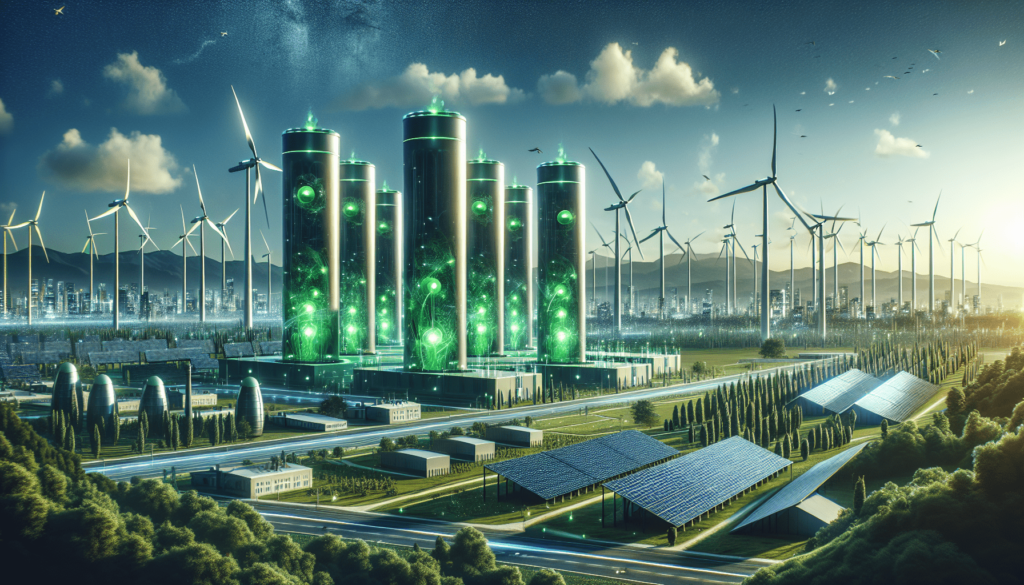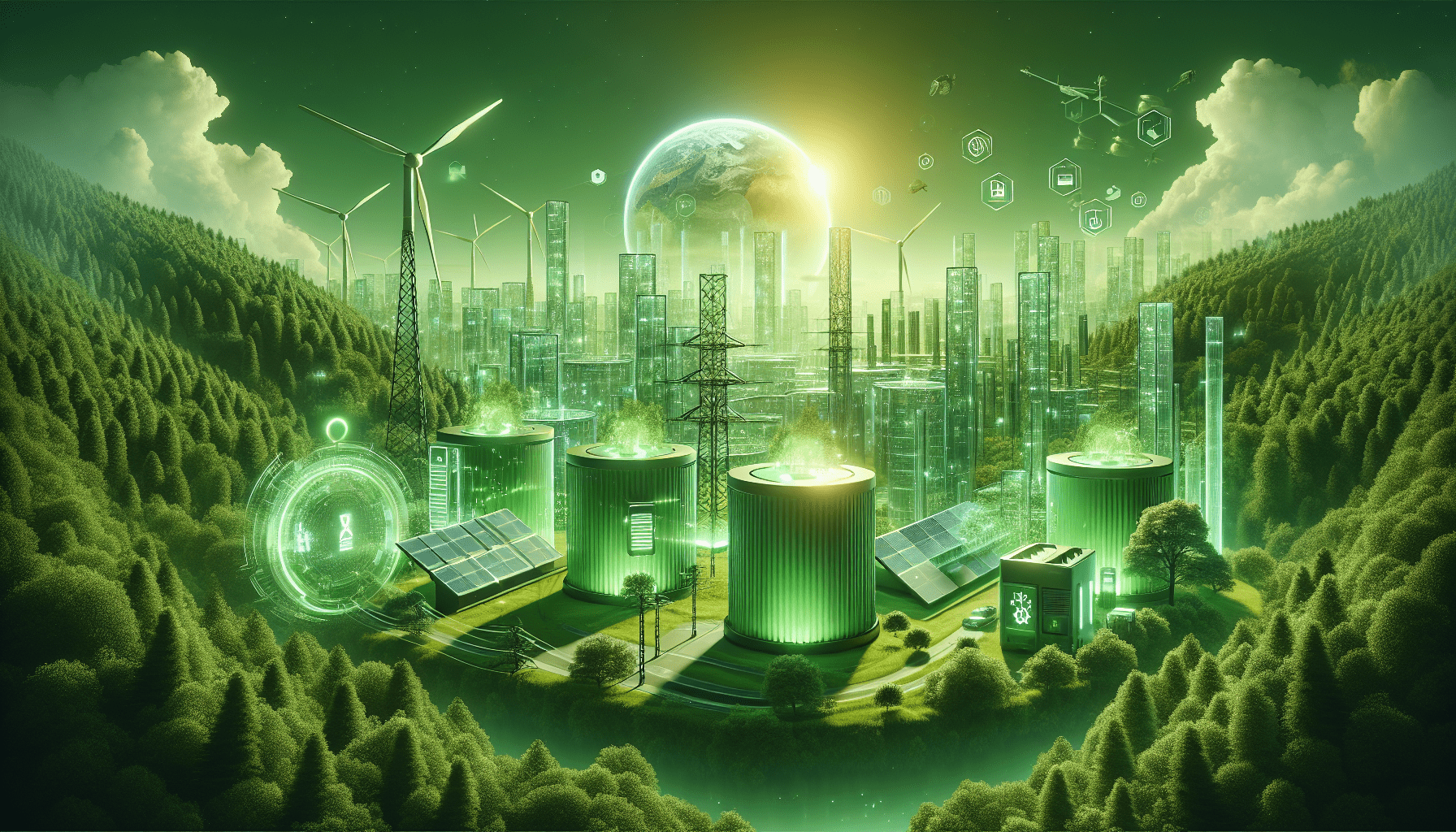Imagine a world where renewable energy sources power our homes, cars, and cities, reducing our dependence on fossil fuels and minimizing our impact on the environment. This is not just a fantasy; it is a vision that is becoming a reality with the advancements in green energy storage solutions. From innovative battery technologies to smart grids and advanced energy management systems, the future of green energy storage holds great promise. In this article, we will explore some of the exciting developments in this field and how they are shaping the way we store and utilize renewable energy. Get ready to be inspired by the limitless potential of green energy storage solutions.
Introduction to Green Energy Storage Solutions
Green energy storage solutions refer to the technologies, techniques, and systems used to efficiently store and manage energy from renewable sources such as solar, wind, and hydro power. These solutions play a crucial role in addressing the intermittency and variability of renewable energy sources, ensuring a stable and reliable power supply. Green energy storage has gained increasing importance as the world transitions to a more sustainable and cleaner energy future.
Current Challenges in Green Energy Storage
Intermittency of renewable energy sources
One of the major challenges in utilizing renewable energy sources is the intermittency of power generation. Solar and wind power generation can fluctuate based on weather conditions and time of day. Green energy storage solutions help to mitigate this challenge by storing excess energy during periods of high generation and releasing it during periods of low or no generation. This enables a more consistent supply of electricity, reducing the reliance on conventional fossil fuel-based power plants.
Lack of efficient and cost-effective storage solutions
The current lack of efficient and cost-effective energy storage solutions poses a significant challenge to the widespread adoption of renewable energy. While renewable energy technologies have experienced significant cost reductions, energy storage systems have not kept pace. However, ongoing advancements in battery technologies and exploration of alternative storage technologies have shown promise in addressing this challenge.
Grid integration difficulties
Integrating renewable energy sources into existing power grids can present technical and operational challenges. The variable nature of renewable energy generation requires a flexible and adaptive grid infrastructure. Green energy storage solutions aid in grid integration by providing a buffer, balancing the supply and demand, and enabling a smooth and reliable transition to a renewable energy-based grid.

Advancements in Battery Technologies
Lithium-ion batteries
Lithium-ion batteries have emerged as the leading technology for energy storage, due to their high energy density, long cycle life, and declining costs. This technology has revolutionized portable electronics and electric vehicles, and is increasingly being deployed for grid-scale energy storage applications. Ongoing research and development aim to further enhance the performance, cost-effectiveness, and environmental sustainability of lithium-ion batteries.
Solid-state batteries
Solid-state batteries represent the next generation of energy storage technology, offering increased energy density and improved safety compared to traditional lithium-ion batteries. These batteries employ solid electrolytes instead of liquid or gel-based electrolytes, enabling higher energy storage capacity and faster charging rates. Although still in the early stages of development, solid-state batteries hold the potential to shape the future of green energy storage.
Flow batteries
Flow batteries store energy in two tanks containing electrolyte solutions, separated by a membrane. Energy is stored in the form of electrochemical reactions between the electrolyte solutions. Flow batteries offer the advantage of decoupling power and energy, allowing for scalable storage capacity. Vanadium redox flow batteries are the most widely used, but research is underway to develop more cost-effective and efficient flow battery chemistries.
Exploration of Alternative Energy Storage Technologies
Hydrogen storage
Hydrogen storage provides a unique solution for long-duration storage and transportation of energy. Electrolysis is used to convert surplus electricity into hydrogen gas, which can then be stored and used later for power generation or as a clean fuel for transportation. Hydrogen storage has the advantage of high energy density and compatibility with existing gas infrastructure, making it a promising option for large-scale energy storage.
Compressed air energy storage
Compressed air energy storage systems store energy by compressing air and storing it in underground caverns or large containers. During periods of high electricity demand, the compressed air is released, running through turbines to generate electricity. This technology has the potential for high energy storage capacity and long-duration storage, contributing to the stability and reliability of the grid.
Thermal energy storage
Thermal energy storage (TES) systems capture and store thermal energy for later use. TES can be achieved using a variety of methods, such as storing heat in molten salt or using phase change materials. These systems can be integrated with concentrated solar power plants, capturing excess heat during periods of high solar radiation and releasing it when needed. TES offers a flexible and dispatchable form of energy storage, enhancing the efficiency and reliability of renewable energy systems.

Role of Artificial Intelligence in Green Energy Storage
AI-powered energy management systems
Artificial intelligence (AI) technology plays a critical role in optimizing the performance and efficiency of green energy storage systems. AI-powered energy management systems can analyze complex data patterns and optimize the operation of storage assets. These systems help to maximize energy utilization, improve response times, and enhance system reliability.
Optimized energy storage scheduling
AI algorithms can optimize energy storage scheduling, considering factors such as electricity prices, demand patterns, and renewable energy generation forecasts. By intelligently dispatching stored energy during peak periods or when electricity prices are high, AI can help reduce overall costs and maximize the value of energy storage systems.
Predictive maintenance of storage systems
AI can also enable predictive maintenance of energy storage systems, detecting potential issues before they cause significant disruptions or failures. By analyzing real-time data and historical performance, AI algorithms can identify patterns and predict maintenance requirements, minimizing downtime and improving the lifespan of energy storage assets.
Grid Integration Solutions for Renewable Energy
Smart grid technologies
Smart grid technologies enable bidirectional communication between the utility and end-users, optimizing the integration of renewable energy sources and energy storage systems. Advanced metering infrastructure, distribution automation, and demand response programs are examples of smart grid solutions that enhance the flexibility and reliability of the grid.
Virtual power plants
Virtual power plants (VPPs) aggregate distributed energy resources, including renewable energy sources and energy storage systems, into a coordinated network. By integrating and managing these resources as a single entity, VPPs can enhance grid stability and optimize energy dispatch. VPPs have the potential to enable greater renewable energy penetration while providing ancillary grid services.
Demand response programs
Demand response programs incentivize consumers to adjust their electricity consumption patterns during periods of high demand or low renewable energy generation. By encouraging consumers to shift their electricity usage to off-peak hours or reduce energy consumption during critical periods, demand response programs help balance the grid and optimize energy utilization.
Innovative Energy Storage Systems
Vehicle-to-grid technology
Vehicle-to-grid (V2G) technology enables bidirectional energy flow between electric vehicles (EVs) and the grid. EVs can serve as mobile energy storage units, providing electricity to the grid during peak demand periods or when renewable energy generation is low. V2G technology offers the potential for widespread deployment of distributed energy storage, leveraging the increasing adoption of EVs.
Hybrid energy storage systems
Hybrid energy storage systems combine multiple storage technologies, such as lithium-ion batteries, flow batteries, and supercapacitors, to optimize performance and flexibility. By leveraging the specific strengths of each technology, hybrid systems can enhance energy storage capacity, improve efficiency, and address different energy storage requirements.
Decentralized energy storage networks
Decentralized energy storage networks distribute energy storage assets across various locations, reducing transmission losses and enhancing grid resilience. These networks enable communities or industrial facilities to store excess energy locally and utilize it when needed, minimizing reliance on centralized power plants and improving energy self-sufficiency.
Green Energy Storage for Rural and Off-grid Communities
Microgrids for rural electrification
Microgrids provide self-contained electricity generation and distribution systems, often used in remote or rural areas with limited access to the main power grid. Renewable energy sources, such as solar or wind, coupled with energy storage systems, enable microgrids to provide reliable and sustainable electricity for off-grid communities. Microgrids improve energy access and support economic development in rural areas.
Small-scale energy storage solutions
Small-scale energy storage solutions cater to the energy needs of individual households or small businesses. These systems, such as home batteries or portable energy storage devices, enable individuals to store excess energy generated from rooftop solar panels or other renewable sources. Small-scale energy storage empowers individuals to become energy self-sufficient and reduce reliance on the grid.
Community-based renewable energy projects
Community-based renewable energy projects involve collective efforts to develop and utilize renewable energy sources and storage systems at the community level. These projects promote community engagement, increase energy independence, and foster sustainable development. Community ownership and participation in renewable energy projects contribute to the resilience and social benefits of green energy storage.
Policy and Regulatory Frameworks for Green Energy Storage
Incentives for energy storage adoption
Policy and regulatory frameworks play a critical role in incentivizing the adoption of green energy storage solutions. Governments can provide financial incentives, such as tax credits or grants, to encourage investment in energy storage systems. Renewable portfolio standards and feed-in tariffs can also drive the integration of energy storage into renewable energy projects.
Grid codes and standards
Grid codes and standards define the technical requirements for connecting renewable energy sources and energy storage systems to the grid. These regulations ensure the safe and reliable operation of the grid and provide clarity for developers and investors. Grid codes and standards are essential for grid integration and the seamless operation of green energy storage solutions.
Interconnection policies
Interconnection policies govern the process of connecting renewable energy and energy storage systems to the grid. Streamlining interconnection procedures and providing clear guidelines facilitate the integration and deployment of green energy storage projects. Emphasizing the importance of interconnection policies can accelerate the adoption of energy storage and support the transition to a greener energy system.
Future Outlook and Challenges
Scalability and commercial viability
Despite significant progress, scalability and commercial viability remain key challenges for green energy storage solutions. The ability to scale up storage technologies and make them cost-competitive with conventional fossil fuel-based power plants is essential for large-scale deployment. Continued research, development, and innovation are necessary to drive down costs and improve the performance of energy storage systems.
Environmental and sustainability concerns
While green energy storage solutions contribute to reducing greenhouse gas emissions and enhancing sustainability, they are not without environmental considerations. The extraction and production of materials for battery technologies, for example, can have environmental impacts. It is crucial to address and mitigate these concerns through sustainable sourcing, recycling, and improving the lifecycle sustainability of energy storage systems.
Integration of storage in global energy systems
The integration of green energy storage into global energy systems presents both opportunities and challenges. As renewable energy penetration increases, robust and flexible storage systems will be essential for grid stability and reliability. However, the integration of storage technologies with existing infrastructure and market mechanisms requires careful planning, coordination, and regulatory support.
In conclusion, green energy storage solutions are pivotal in addressing the challenges associated with integrating renewable energy into existing power systems. Advancements in battery technology, exploration of alternative storage technologies, and the role of artificial intelligence are revolutionizing the energy storage landscape. Grid integration solutions, innovative energy storage systems, and policies supporting their adoption are vital for a sustainable energy future. Despite future outlook and challenges, the future of green energy storage solutions looks promising, with potential for significant growth and transformation of the global energy sector.

